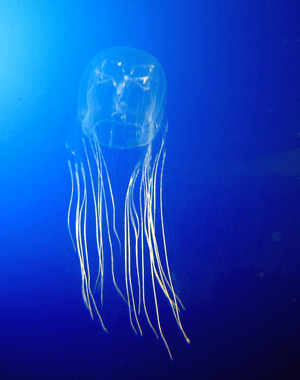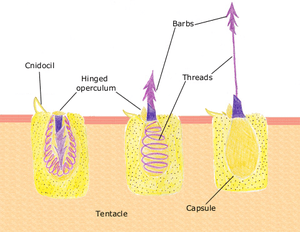Box jellyfish
Background

Box jellyfish

Nematocyst stages of discharge
- Cnidarian invertebrates distinguished by their cube-shaped medusae
- Chironex fleckeri or sea wasp is cause of most deaths
- Largely restricted to the Indo-Pacific Ocean/Australian waters but various species can be found widely
- Most stings are benign (requiring local treatment only), only a few species have been implicated in human deaths
Mechanism
- Specific venom components unclear
- Thought to affect sodium/potassium/calcium channels
- Chironex fleckeri venom causes cell membranes to become porous allowing K+ influx/hyperkalemia
Clinical Features
- Stings associated with immediate pain, lasting up to 8 hours, and linear welts in a cross-hatched pattern
- May progress to blisters/necrosis
- 25-30% may still have tentacles attached
- Systemic envenomation (usually >10% BSA) can manifest as cardiac arrhythmias, respiratory dysfunction, death
- usually manifests within 5 minutes of sting
- delayed hypersensitivity reactions occur in >50%
- Itching, redness at sting sites 7-14d after initial incidence
Differential Diagnosis
Marine toxins and envenomations
- Toxins
- Stingers
- Venomous fish (catfish, zebrafish, scorpion fish, stonefish)
- Cone shells
- Lionfish
- Sea urchins
- Nematocysts
- Coral reef
- Fire coral
- Jellyfish (Cnidaria)
- Portuguese man-of-war
- Sea anemones
- Phylum porifera (sponges)
- Bites
Evaluation
- Generally a clinical diagnosis
Management
- Pour liberal amounts of vinegar
- Remove any tentacles
- tentacles separated from medusae can still emit venom
- Pain control
- Supportive measures for minor envenomations
- Ice recommended but heat may actually work better
- Antihistamines and steroids for hypersensitivity reaction
- Do NOT pressure bandage
- Antivenom for life-threatening envenomations
- Bovine IgG Fab with 20,000 units/ampule
Antivenom Indications^
- Cardiac arrest
- undiluted antivenom administered as an IV Push: up to 6 vials
- if no response then give magnesium IV
- Hypotension, tachycardia, shock, arrhythmia
- dilute 3 amps antivenom in 100mL NS and run over 20 minutes
- can repeat for a total of 6 vials
- Intractable pain
- give 1 amp diluted in 100mL NS run over 20 minutes
Anti-venom can cause serum sickness 4-14 days after administration
Disposition
References
- Bastian Bentlage, Paulyn Cartwright, Angel A. Yanagihara, Cheryl Lewis, Gemma S. Richards and Allen G. Collins.Evolution of box jellyfishes (Cnidaria: Cubozoa), a group of highly toxic invertebrates. Proceedings of the Royal Society, November 18, 2009 DOI:10.1098/rspb.2009.1707
- Currie BJ, Jacups SP. Prospective study of Chironex fleckeri and other box jellyfish stings in the “Top End” of Australia’s Northern Territory. Med J Aust 2005; 183: 631-636
- Hughes RJ, Angus JA, Winkel KD, Wright CE. A pharmacological investigation of the venom extract of the Australian box jellyfish, Chironex fleckeri, in cardiac and vascular tissues. Toxicol Lett. 2012 Feb 25;209(1):11-20. Epub 2011 Dec 2.
- http://www.toxinology.com/generic_static_files/cslavh_antivenom_boxjelly.html
This article is issued from
Wikem.
The text is licensed under Creative
Commons - Attribution - Sharealike.
Additional terms may apply for the media files.